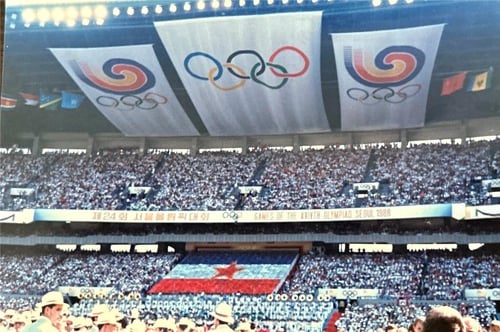Over the next three weeks, as you catch up on the latest Olympic news via the BBC Sport app, stream the 100m final live while sitting on a train, watch last night’s events on playback or access your digital ticket if you are lucky enough to be attending an event, just think about the amazing technology that makes this all possible.
I love the Olympics. I love watching it, reading about it, talking about it and the fact that I can consume it in so many ways, makes it even more captivating. My passion for the Olympics is derived from the fact that in 1988 I was honoured to be part of Team GB at the 24th Olympiad in Seoul, South Korea. After years of dedication, training and sacrifice, I was selected to compete in Artistic Swimming. Each time another Olympiad approaches, I cast my mind back and think how different it was to be an athlete thirty-six years ago!

Seoul was billed as the first ‘computerised’ Olympics, yet at that time the public launch of the internet was five years away, the first SMS message had not been sent, we didn’t have mobile phones, our photos were all on 35mm film, there was no magic eye technology and a 14x9 metre video matrix scoreboard was something to shout about.
But Seoul did give me the opportunity to send my first electronic message. In 1984, the Korean Advanced Institute of Science and Technology (KAIST) started development of a computerised system for the games which eventually was called WINS - Wide Information Network Services (not the same as the Microsoft service). It provided an information retrieval system and electronic messaging service, with over 332K messages sent between athletes, officials, organisers and the media during the games. It provided us with great entertainment, and I still have hard copies of messages I received from other athletes, printed out on a dot matrix printer using continuous computer paper (youngsters – look that one up). We would eagerly log on to check for any messages. The novelty is not the same today when I log in on a Monday morning to read my email!
WINS wasn’t the only system that was built by KAIST for the games. GIONS (Games Information On-line Network systems) was created for results processing, athlete accreditation and competition management, all running on an IBM 4381 mainframe computer with 64MB of memory, supported by 47 minicomputers at the competition venues. Compare this to Paris 2024 where there will be 12,000 connected screens, 8,000 Wi-Fi terminals, 13,000 computers and 400,000 km of optical fiber.
Technology and the IOC

Over the years, the International Olympic Committee (IOC) have a developed a vision and strategy to transform the Olympic Games for the digital era. One example of this has involved removing the reliance on building and then decommissioning multiple data centres at each venue, with Tokyo 2020/2021 being the first to go with a 100% cloud-based approach.
In April 2024, in a groundbreaking initiative, the IOC launched the Olympic Artificial Intelligence Agenda. This sets out a governance and oversight framework to promote the responsible use of AI and lays out the IOC commitment to leverage the power of AI across the Olympic Ecosystem.
Athletes/human beings are at the centre of the Olympic movement, so the societal question of whether AI will replace human beings is not really applicable. A robot is never going to swim the 50m freestyle! However, the potential for AI to support athletes and improve the audience experience is vast.
For you
Be part of something bigger, join BCS, The Chartered Institute for IT.
In Paris over the next few weeks, AI will play an integral role in many aspects of the games. When you are catching up on Dina Asher-Smith in the 100m, Andrea Spendolini-Sirieix throwing herself off the 10m platform, or Simone Biles on the beam, AI will be enhancing your viewing pleasure like never before. A record number of multi-camera replay systems will create three dimensional models and compelling replays from an array of camera angles. Intel will use AI to create automatic highlight reels, personalised to your preferences. In diving, AI will be used to generate enhanced data graphics, providing a whole new set of data on each athlete’s performance in the air and as they hit the water.
With a predicted half a billion social media posts during the games, AI will also play an important safeguarding role in protecting the athletes. Abusive posts, which are sadly quite common, will be flagged to the relevant platforms for removal.
The possibilities are endless. Given how far technology has moved on since Seoul 1988, I wonder what the Olympic Games 2060 will look like.
Next week I will once again get the chance to savour a little bit of Olympic magic. I was lucky enough to win two tickets in the World Olympian ballot to see the Women’s Artistic Gymnastics All-Around Final, so my daughter and I will be joining the thousands of sports fans in Paris! There will be no paper ticket this time though…I’ve got my QR code at the ready!

















